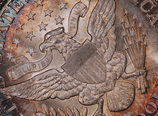Will the Efficiency of the TPGs Naturally Lead to all Worthwhile Coins Becoming Overgraded?
 He had to submit the same coin to the TPGs 242-times to finally achieve the upgrade. Here, he is seen standing on the pile of gold, which represents the overpayment from the collector who bought the coin thinking it was fresh and solid for the newly assigned grade.
He had to submit the same coin to the TPGs 242-times to finally achieve the upgrade. Here, he is seen standing on the pile of gold, which represents the overpayment from the collector who bought the coin thinking it was fresh and solid for the newly assigned grade.
I'm a big fan of third party grading (TPGs) when done by the established, highly reputable firms in the business today. In my neck of the woods, gem and near-gem type as well as better date coins, there is a clear collector preference to PCGS certified pieces. However, NGC has also long held its own as an established player in this field and many collectors rely on them heavily, too.
It seems to me, from my many years participation on the coin bourse and various internet boards, that there are two large pools of submitters to the TPGs who are pushing the question asked in this blog entry title toward an affirmative statement. The two pools would be the wide body of collectors and vest-pocket dealers who resubmit their collection coins or coins from inventory when they believe there is a sliver of a chance at an upgrade along with the significantly smaller group of dealers who make a living on the regrades of coins that are already certified and freely trading in the marketplace. While the former pool is larger, the latter pool is typically more savvy and aggressive. What both pools have in common is money and the hope that whatever coins they have on-hand are worth the most that they can be worth at any given time.
Therefore, that freshly or relatively recently certified better date coin or pop one registry trophy may very well have been through the system more than once. In fact, depending upon the dollar spread between grades, that newly prized possession might have seen one or both major grading services dozens of times before finally landing in your collection. The coin might be "fresh" to the larger market, but might be stale as far as the TPGs and experienced dealers are concerned. Of course, that would only represent a single coin and could hardly impact the supply of pieces in our hobby-industry. The previous would be a true supposition if it weren't for the aforementioned armies of collectors, vest-pocket dealers and dedicated full-time dealers who are all looking to max out the grade of every coin for their own reasons. Please take note that the desire to max out a grade and the willingness to submit the same coin multiple times to the review process has nothing inherently evil or deceptive about it. After all, any grade on a TPG holder is simply a single data point in time and that data point is only good for as long as that coin resides in that holder. Break the coin out and scratch it? That data point is gone. Break the coin out and resubmit again, and again, and again? That data point, and subsequent data points, are gone. Alternatively, what coins will not be cracked out for regrade? Those coins that have no chance at grading higher and might, in fact, grade lower. This cycle leads to more and more coins representing less and less value in their given grades over time as so many pieces will have been pushed to the highest grade possible.
If we follow through on that logic then an enormous number of "worthwhile" coins will play the grade-regrade game until their owners give up or receive the grade they want; or even higher than they want. Those pieces are often known as "coffin coins" because they are in a slab that will never be broken open. Alternatively, some dealers call them "happy coins" because they are overgraded beyond their wildest dreams. I attempt to buy accurately or conservatively graded coins. These would be pieces that stand little, if any, chance of being downgraded if resubmitted, which is something that would happen to an alarmingly high percentage of "coffin" or "happy" coins; while at the same time they might even upgraded for those willing to play the game. I often pay strongly for these coins and offer them at similarly strong prices to my clients, but oftentimes we are likeminded in such matters.
The advent of freely available internet databases hosted by various companies has made the research into how many times a coin might grade what it grades now that much easier. It has also allowed folks to track a coin while it has made a march up the grading ladder over the years. These are not failsafe models to protect oneself, but they are far more than what was available to the general public even just a decade ago. I would suggest to take the time to research possible purchases as well as to realize that true quality in coinage can cost more, sometimes significantly more, than something where resources have been spent so assure a max out in the grade. It is your money and your collection; decide what it will represent to other knowledgeable folks.
It seems to me, from my many years participation on the coin bourse and various internet boards, that there are two large pools of submitters to the TPGs who are pushing the question asked in this blog entry title toward an affirmative statement. The two pools would be the wide body of collectors and vest-pocket dealers who resubmit their collection coins or coins from inventory when they believe there is a sliver of a chance at an upgrade along with the significantly smaller group of dealers who make a living on the regrades of coins that are already certified and freely trading in the marketplace. While the former pool is larger, the latter pool is typically more savvy and aggressive. What both pools have in common is money and the hope that whatever coins they have on-hand are worth the most that they can be worth at any given time.
Therefore, that freshly or relatively recently certified better date coin or pop one registry trophy may very well have been through the system more than once. In fact, depending upon the dollar spread between grades, that newly prized possession might have seen one or both major grading services dozens of times before finally landing in your collection. The coin might be "fresh" to the larger market, but might be stale as far as the TPGs and experienced dealers are concerned. Of course, that would only represent a single coin and could hardly impact the supply of pieces in our hobby-industry. The previous would be a true supposition if it weren't for the aforementioned armies of collectors, vest-pocket dealers and dedicated full-time dealers who are all looking to max out the grade of every coin for their own reasons. Please take note that the desire to max out a grade and the willingness to submit the same coin multiple times to the review process has nothing inherently evil or deceptive about it. After all, any grade on a TPG holder is simply a single data point in time and that data point is only good for as long as that coin resides in that holder. Break the coin out and scratch it? That data point is gone. Break the coin out and resubmit again, and again, and again? That data point, and subsequent data points, are gone. Alternatively, what coins will not be cracked out for regrade? Those coins that have no chance at grading higher and might, in fact, grade lower. This cycle leads to more and more coins representing less and less value in their given grades over time as so many pieces will have been pushed to the highest grade possible.
If we follow through on that logic then an enormous number of "worthwhile" coins will play the grade-regrade game until their owners give up or receive the grade they want; or even higher than they want. Those pieces are often known as "coffin coins" because they are in a slab that will never be broken open. Alternatively, some dealers call them "happy coins" because they are overgraded beyond their wildest dreams. I attempt to buy accurately or conservatively graded coins. These would be pieces that stand little, if any, chance of being downgraded if resubmitted, which is something that would happen to an alarmingly high percentage of "coffin" or "happy" coins; while at the same time they might even upgraded for those willing to play the game. I often pay strongly for these coins and offer them at similarly strong prices to my clients, but oftentimes we are likeminded in such matters.
The advent of freely available internet databases hosted by various companies has made the research into how many times a coin might grade what it grades now that much easier. It has also allowed folks to track a coin while it has made a march up the grading ladder over the years. These are not failsafe models to protect oneself, but they are far more than what was available to the general public even just a decade ago. I would suggest to take the time to research possible purchases as well as to realize that true quality in coinage can cost more, sometimes significantly more, than something where resources have been spent so assure a max out in the grade. It is your money and your collection; decide what it will represent to other knowledgeable folks.
